Egypt 4: Cairo - Modernity and History
Today we met with Neveen's cousins to visit the Egyptian Museum and explore Midan Tahrir, or Freedom Square. We went from Maadi to Sayeed Zaineb on the Metro - Cairo's subway system, which on the outside resembles the Metro from Paris. With some key differences - it is too cheap to take a ride on this metro, and the front car is for women and children only. We boarded the regular cars though – we preferred taking the chance of riding with other men than deal with too many wailing infants. The cars were not air-conditioned despite the 40 degree heat, although the transportation bureau was kind enough to provide three whirring fans in each car.
Sayeed Zeinab is an old area in Cairo, most residents tend to be more traditional and ethnic. As much as they were ogling at an Asian tourist, the rhythm of their lives never seemed to stop and the souk hawkers continued to call out their wares and mothers were still ushering their children.
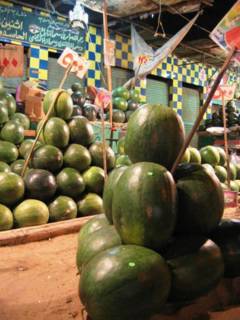
Largest Watermelons
I was amazed at the number of arabaya caru's (donkey carts) in such a crowded place - for the poorer folk, these rudimentary carts were shop front, store room, transportation, and napping spot rolled into one.
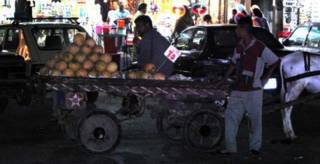
Arabaya Caru
We went to the Egyptian Museum that day, after a heart-stopping adventure trying to cross the Midan Tahrir (Freedom Square) on foot. “Dodge and Run” does not even begin to describe the level of dexterity that is required.
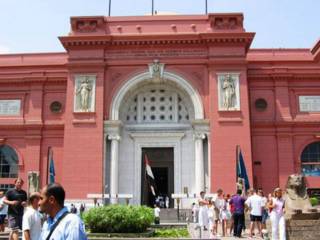
The Egyptian Museum in Cairo is the first attraction I've been in so far that does not require a higher price for foreigners compared to Egyptians. The guards were flirtatious, which wasn't a surprise to me anymore. Almost all men in Cairo have a little bit of the Casanova in them. But that didn’t stop them from placing our cameras under custody, so there are unfortunately no pictorial evidence of what we saw this time.
The museum is hot and stuffy, air conditioning was reserved for the exhibits that needed them, so visitors are left to fan themselves. The exhibit quality is top-notch, but organization of these exhibits leaves much to be desired. It was clear that the museum needed more funding. We went to see the Royal Mummies - the mummified remains of various members from Ancient Egyptian royalty. These included Seti, Ramses, Tutmoses, etc.
These mummies were fascinating- the equivalent of a human raisin. Only their hands and heads were exposed under the glass exhibit case, the rest were still under linen wraps. Arms were arranged in specific layout, mummies from different eras were preserved in different ways, and there were even dried flowers/reeds/decorative items left on these mummies, preserved for over 3000 years.
After the awe of viewing dead royalty wore off, and we went into another exhibit area that had various less noble mummies in storage cases (which were no more than covered library shelves), it hit me with a jolt that I was standing among at least 50 dead bodies, not more than 2 feet away from me, separated by nothing more than a piece of glass. Before my imagination took the better of me, we went on to another chamber that displayed the equipment used during mummification. As macabre as the subject matter was, a lot of science and experimentation actually went into the process of mummification, I suppose no different from conducting bio-science tests on animals or cadavers today.
We did indulge in a little girliness and wondered which of the thousands of jewelry pieces that were discovered in Tutankhamun's tomb we would like to have for ourselves. His Death Mask was opulently decorated with so much detail, his coffins were intricate and clearly made with incredible dedication. What is mind-boggling is that King Tutankhamun was not a remarkable ruler since he was only a young pharaoh, yet he was treated with such opulence upon his death, one can only imagine how the truly great rulers e.g. Seti I, would have been buried and how much treasure was stolen by grave robbers. The country needs to dedicate significant resource to preserve Egypt's heritage in Egypt - Mona said that many times. All the most significant Egyptian artifacts (e.g. the Rosetta Stone) are currently placed in museums in other countries.
We had dinner in an Egyptian classic in Cairo - TGIFridays. Located on the corniche by Zamalack, a very European and yuppified part of Cairo, TGIF was strange but familiar - the menu was what I had expected, however the restaurant plays Arabic pop and I keep having strange 80s flashbacks. But it felt good to eat some french fries again.
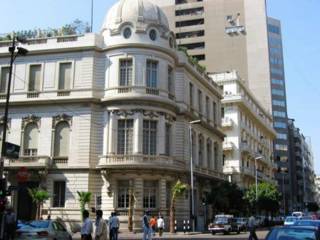
Downtown Cairo
Our walk after dinner was interesting - a mix of poverty and showoffs. Destitute folks trying to sell us penny items from their cardboard campsite, mothers dragging their kids along to beg for money, and local young men calling out comments and trying to impress us by balancing on the bridge railings. Too bad none of them fell into the Nile, would have taught them a lesson.
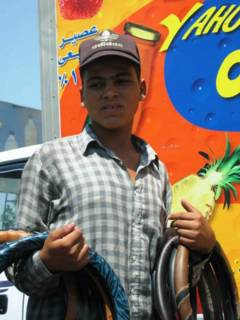
Street Sale
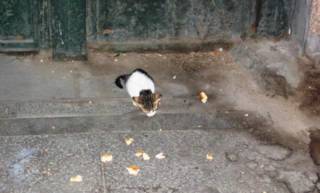
Neveen's Stray Kitten
We went to Khan El Khalili that night. It was exactly what the guide books promised, and more.
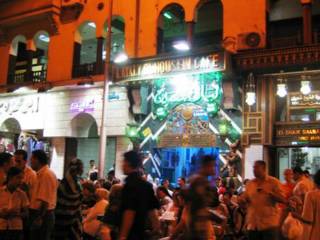
Coffee Shops in Khan el Khalili
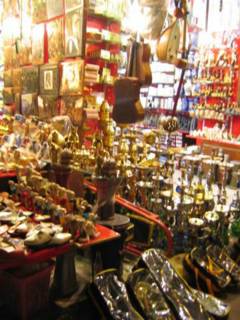
On Display
Khan el Khalili at night was a press of humanity, everyone and their mother were out shopping. And fighting and smoking and drinking tea. Khan is kitsch and art and the incredible enterprise of Egyptian tourism. "I don’t know what you're looking for, but I'm sure I have it," must be the most memorable line called out to me that night.
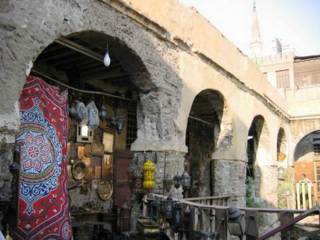
Older Shops
Snaking our way through narrow alleyways and dodging burning light bulbs, kids getting chased by adults for touting in front of their shops, respectfully nodding to octogenarians chatting with their friends in front of Masjid al Hussein after prayer, a miscreant getting told off by others for inappropriately touching a customer. Khan el Khalili at night was a wonderland.

Perfume Shop
One memorable stop in Khan El Khalili is a store that sells antiques, called literally The Old Shop.
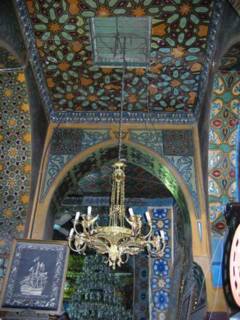
This was one of the first shops in Khan, it is 110 years old. The main salesperson, an enterprising man in his 60s, had been working there since Junior High school. The interior of store is remarkable, ceilings and walls were decorated with complex floral paints accompanied by intricately designed ceiling fans and lamps. I bought two little Aladdin lamps – my very own private genies.
The crowd in front of Masjid Al Hussein, which is a mosque that has enshrined the head of the Prophet Mohammed's grandson, was truly a colorful fabric of Cairo society.
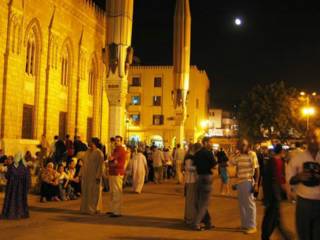
A well-to-do family that were out to visit their favorite air-conditioned jewelry store, were on their mobile phones placing an order for the design they liked with their private jeweler. The middle-class family who had come to pray at the mosque now sits on the steps in front enjoying a little picnic and the cool night breezes. The poorer family worshipped here because anywhere else was too far and expensive to travel to. After prayer, kids kicked around a flattened Coke can until the first kid got it between two guard posts and he jubilantly yelled "Goal!!!!" The truly destitute either begged for alms in front of the mosque, or sold penny-items ranging from tissue packets to garlands of jasmine. Half the time I didn’t know how to react, and found myself gawking at this sea of humanity with my camera at the ready while my mouth hung open like the proverbial tourist. How gauche.
Next: The Citadel http://atygerontheloose.blogspot.com/2004/08/egypt-5-citadel-religion-culture-and.html
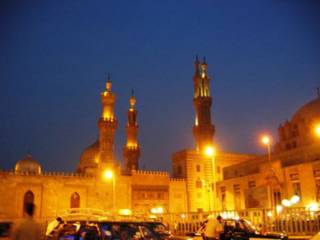
Al-Azhar School of Islam
Sayeed Zeinab is an old area in Cairo, most residents tend to be more traditional and ethnic. As much as they were ogling at an Asian tourist, the rhythm of their lives never seemed to stop and the souk hawkers continued to call out their wares and mothers were still ushering their children.

Largest Watermelons
I was amazed at the number of arabaya caru's (donkey carts) in such a crowded place - for the poorer folk, these rudimentary carts were shop front, store room, transportation, and napping spot rolled into one.

Arabaya Caru
We went to the Egyptian Museum that day, after a heart-stopping adventure trying to cross the Midan Tahrir (Freedom Square) on foot. “Dodge and Run” does not even begin to describe the level of dexterity that is required.

The Egyptian Museum in Cairo is the first attraction I've been in so far that does not require a higher price for foreigners compared to Egyptians. The guards were flirtatious, which wasn't a surprise to me anymore. Almost all men in Cairo have a little bit of the Casanova in them. But that didn’t stop them from placing our cameras under custody, so there are unfortunately no pictorial evidence of what we saw this time.
The museum is hot and stuffy, air conditioning was reserved for the exhibits that needed them, so visitors are left to fan themselves. The exhibit quality is top-notch, but organization of these exhibits leaves much to be desired. It was clear that the museum needed more funding. We went to see the Royal Mummies - the mummified remains of various members from Ancient Egyptian royalty. These included Seti, Ramses, Tutmoses, etc.
These mummies were fascinating- the equivalent of a human raisin. Only their hands and heads were exposed under the glass exhibit case, the rest were still under linen wraps. Arms were arranged in specific layout, mummies from different eras were preserved in different ways, and there were even dried flowers/reeds/decorative items left on these mummies, preserved for over 3000 years.
After the awe of viewing dead royalty wore off, and we went into another exhibit area that had various less noble mummies in storage cases (which were no more than covered library shelves), it hit me with a jolt that I was standing among at least 50 dead bodies, not more than 2 feet away from me, separated by nothing more than a piece of glass. Before my imagination took the better of me, we went on to another chamber that displayed the equipment used during mummification. As macabre as the subject matter was, a lot of science and experimentation actually went into the process of mummification, I suppose no different from conducting bio-science tests on animals or cadavers today.
We did indulge in a little girliness and wondered which of the thousands of jewelry pieces that were discovered in Tutankhamun's tomb we would like to have for ourselves. His Death Mask was opulently decorated with so much detail, his coffins were intricate and clearly made with incredible dedication. What is mind-boggling is that King Tutankhamun was not a remarkable ruler since he was only a young pharaoh, yet he was treated with such opulence upon his death, one can only imagine how the truly great rulers e.g. Seti I, would have been buried and how much treasure was stolen by grave robbers. The country needs to dedicate significant resource to preserve Egypt's heritage in Egypt - Mona said that many times. All the most significant Egyptian artifacts (e.g. the Rosetta Stone) are currently placed in museums in other countries.
We had dinner in an Egyptian classic in Cairo - TGIFridays. Located on the corniche by Zamalack, a very European and yuppified part of Cairo, TGIF was strange but familiar - the menu was what I had expected, however the restaurant plays Arabic pop and I keep having strange 80s flashbacks. But it felt good to eat some french fries again.

Downtown Cairo
Our walk after dinner was interesting - a mix of poverty and showoffs. Destitute folks trying to sell us penny items from their cardboard campsite, mothers dragging their kids along to beg for money, and local young men calling out comments and trying to impress us by balancing on the bridge railings. Too bad none of them fell into the Nile, would have taught them a lesson.

Street Sale

Neveen's Stray Kitten
We went to Khan El Khalili that night. It was exactly what the guide books promised, and more.

Coffee Shops in Khan el Khalili

On Display
Khan el Khalili at night was a press of humanity, everyone and their mother were out shopping. And fighting and smoking and drinking tea. Khan is kitsch and art and the incredible enterprise of Egyptian tourism. "I don’t know what you're looking for, but I'm sure I have it," must be the most memorable line called out to me that night.

Older Shops
Snaking our way through narrow alleyways and dodging burning light bulbs, kids getting chased by adults for touting in front of their shops, respectfully nodding to octogenarians chatting with their friends in front of Masjid al Hussein after prayer, a miscreant getting told off by others for inappropriately touching a customer. Khan el Khalili at night was a wonderland.

Perfume Shop
One memorable stop in Khan El Khalili is a store that sells antiques, called literally The Old Shop.

This was one of the first shops in Khan, it is 110 years old. The main salesperson, an enterprising man in his 60s, had been working there since Junior High school. The interior of store is remarkable, ceilings and walls were decorated with complex floral paints accompanied by intricately designed ceiling fans and lamps. I bought two little Aladdin lamps – my very own private genies.
The crowd in front of Masjid Al Hussein, which is a mosque that has enshrined the head of the Prophet Mohammed's grandson, was truly a colorful fabric of Cairo society.

A well-to-do family that were out to visit their favorite air-conditioned jewelry store, were on their mobile phones placing an order for the design they liked with their private jeweler. The middle-class family who had come to pray at the mosque now sits on the steps in front enjoying a little picnic and the cool night breezes. The poorer family worshipped here because anywhere else was too far and expensive to travel to. After prayer, kids kicked around a flattened Coke can until the first kid got it between two guard posts and he jubilantly yelled "Goal!!!!" The truly destitute either begged for alms in front of the mosque, or sold penny-items ranging from tissue packets to garlands of jasmine. Half the time I didn’t know how to react, and found myself gawking at this sea of humanity with my camera at the ready while my mouth hung open like the proverbial tourist. How gauche.
Next: The Citadel http://atygerontheloose.blogspot.com/2004/08/egypt-5-citadel-religion-culture-and.html

Al-Azhar School of Islam

0 Comments:
Post a Comment
<< Home